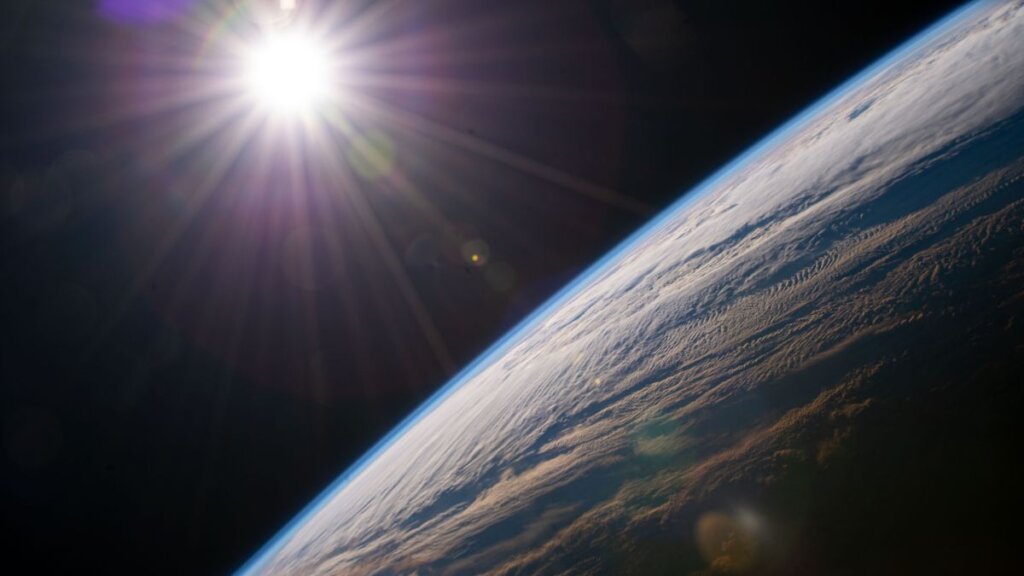The length of Earth’s day is only 24 hours, rather than over 60 hours, thanks to a temporary balance between the gravitational tidal forces from the moon and the sun.
When the moon formed about 4.5 billion years ago, probably from a giant impact, it was much closer to Earth than it is now and our planet was spinning much faster, with a day length of less than 10 hours. Since then, the moon has been gradually moving outward, stealing some of Earth’s angular momentum, with the result that Earth’s rotation has slowed. Today, as we all know, a day on Earth lasts 24 hours.
However, at the rate at which the moon is moving away from us — measured to be 1.49 inches (3.78 centimeters) per year by experiments using laser reflectors left on the moon by Apollo astronauts — our planet should have slowed to the point of having 60-hour-long days. So what slowed the slowing down?
Related: Everything you need to know about planet Earth
Astronomers from the University of Toronto and the University of Bordeux, led by Toronto’s Hanbo Wu, now have an answer. It’s all related to a balance in the torques created by thermal tides in Earth’s atmosphere and the gravitational tides emanating from the moon.
As we know, the moon’s gravity pulls on Earth’s oceans, resulting in high tides on opposite sides of the planet as the ocean bulge follows the moon around our planet. More mass in the ocean tidal bulge means the moon’s gravity pulls on it more, and, coupled with the effects of friction between the ocean tides and the sea floor, the end result is a slowing of Earth’s spin by about 1.7 milliseconds each century.
However, thermal tides in Earth’s atmosphere are able to counteract this breaking effect if the period with which they reverberate around the planet enters into a resonance with Earth’s rotation. The temperature of the atmosphere controls the velocity of the thermal waves, and as the atmosphere warms, it swells, creating another kind of bulge.
“Sunlight also produces an atmospheric tide with the same types of bulges,” Norman Murray, of the Canadian Institute for Theoretical Astrophysics at the University of Toronto, said in a statement. “The sun’s gravity pulls on these atmospheric bulges, producing a torque on the Earth, but instead of slowing down Earth’s rotation like the moon, it speeds it up.”
For most of Earth’s history, the lunar tides have been 10 times stronger than the thermal tides, resulting in Earth’s rotation slowing down. However, based on atmospheric global circulation models and geological evidence of bands in sedimentary rocks corresponding to spring and neap tides in the past, this all changed between 2.2 billion and 600 million years ago.
As the atmosphere warmed (as evidenced by the lack of glaciation during this period), the thermal tides grew larger and faster until they entered a resonant frequency with Earth’s rotation. A resonance is a kind of amplification. The common analogy is a child on a swing — give them a push at just the right time, synchronous with the arc of their swing, and they swing faster and higher. Something similar happens with resonances in nature.
About 2.2 billion years ago, the thermal tides began traveling around Earth with a period of nearly 10 hours, while Earth’s day length was 19.5 hours. In other words, the thermal tides traveled around Earth twice for every single rotation of Earth on its axis, a resonance of 2:1. This resonance just amplified the thermal tides, so the atmospheric bulge grew larger and the sun‘s pull became significant enough to match that of the moon.
Related: What is the moon phase today? Lunar phases 2023
Consequently, the slowing down of Earth’s rotation by the moon’s tides began to be counterbalanced by the speeding up incurred by the thermal tides. For that long period of time between 2.2 billion years and 600 million years ago, Earth’s length of day did not continue to slow, but remained at 19.5 hours.
Eventually, the two tidal forces moved out of sync, and over the past 600 million years Earth’s rotation has subsequently begun slowing down again. Today, the length of day is 24 hours, while the thermal tides take 22.8 hours to travel around Earth.
However, this situation is not fixed. Although recent measurements have found Earth’s rotation to be speeding up marginally, over the long term Earth probably won’t return to the days of the tidal forces balancing each other out. Instead, climate change could move the thermal tides farther out of sync with planetary rotation, increasing the effect that lunar tides have on slowing the planet.
“As we increase Earth’s temperature with global warming, we’re also making this resonant frequency move higher — we’re moving our atmosphere farther away from resonance,” said Murray. “As a result, there’s less torque from the sun and therefore the length of day is going to get longer sooner than it would otherwise.”
The new findings were published on July 5 in the journal Science Advances.

